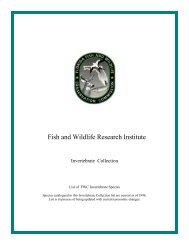STOCK ASSESSMENT OF WHITE GRUNT FROM THE WEST ...
STOCK ASSESSMENT OF WHITE GRUNT FROM THE WEST ...
STOCK ASSESSMENT OF WHITE GRUNT FROM THE WEST ...
You also want an ePaper? Increase the reach of your titles
YUMPU automatically turns print PDFs into web optimized ePapers that Google loves.
had a peak in spawning activity during March through to June (Padgett 1997) and therefore had a<br />
similar spawning season as white grunt from the west coast of Florida.<br />
White grunt south of Florida have been observed spawning by Evermann and Marsh (1902)<br />
in August and September off Puerto Rico. Erdman (1956, 1977), however, observed ripe white<br />
grunts off Puerto Rico in the spring (February to April with a peak in March) and in the fall<br />
(September and November). In Jamaica, white grunt spawn year-round, although there is a<br />
maximum amount of spawning during March and April (Munro et al. 1973). Billings and Munro<br />
(1974) similarly observed spawning of white grunt in Jamaica from January through April , but they<br />
also observed a secondary spawning peak in October and November. The potential for white grunt<br />
to batch-spawn twice a year was important to consider for fish from the west coast of Florida<br />
because fishers had reported seeing white grunt with roe in the fall. Murie and Parkyn (1998, 1999)<br />
only found evidence to support one spawning cycle per year, but multiple year monitoring of the<br />
spawning cycle may be necessary to observe any secondary spawning peak in the fall that does not<br />
consistently occur every year.<br />
Spawning frequency (number of days between sequential spawns) and annual fecundity<br />
have not been estimated for white grunt from the United States. Fecundity has been estimated<br />
for white grunt from Jamaica (Billings and Munro 1974) as:<br />
e = 607w - 93,000, where e = fecundity and w = body weight in grams.<br />
For white grunt from Port Royal, average fecundity was estimated as 42,000 eggs/female per<br />
spawning season, with fish of 220 g average weight (Billings and Munro 1974). On unexploited<br />
reefs of Jamaica (Pedro Bank), fish were an average size of 400 g and were estimated to produce<br />
150,000 eggs per female per spawning season (Billings and Munro 1974).<br />
The sex ratio of grunts captured in the head-boat fishery off the west coast of Florida<br />
during the spawning season was skewed significantly toward males (Murie and Parkyn 1998).<br />
This indicated that female grunts were less catchable using hook-and-line gear than males during<br />
the spawning season. In the post-spawning season, the sex ratio of white grunt in the head-boat<br />
catch was not significantly different from 1:1 (Murie and Parkyn 1998).<br />
Padgett (1997) noted that the overall sex ratio of white grunt captured in MARMAP<br />
sampling and in the commercial fishery in the SAB was significantly skewed toward females.<br />
However, the overall sex ratio was equal among the different age classes of white grunt sampled<br />
by the different gear types (Padgett 1997). Previous information on the sex ratios of white grunt<br />
caught in traps in Jamaica indicated that the sex ratio was skewed toward females (Billings and<br />
Munro 1974).<br />
Age and Growth<br />
Age and growth of white grunt from the west coast of Florida has been recently analyzed<br />
by Murie and Parkyn (1999). Previous to their study, very limited growth rate data (n=5 fish)<br />
were available for fish from the eastern Gulf of Mexico from tag-recapture studies of Moe (1966,<br />
1967). In comparison, age and growth of white grunt is known for fish occurring off the Atlantic<br />
coast of the United States (Manooch 1976, Padgett 1997, Potts and Manooch In review),<br />
Campeche Bank of Mexico (Kapote 1971), and Jamaica (Billings and Munro 1974).<br />
Various methods have been used to age white grunt, including scales (Manooch 1976),<br />
whole sagittal otoliths (Manooch 1976, Murie and Parkyn 1999), and thin-sectioned sagittal<br />
7




